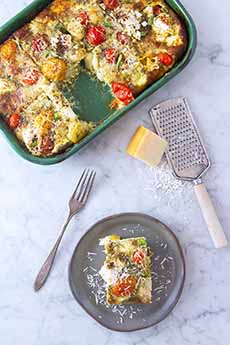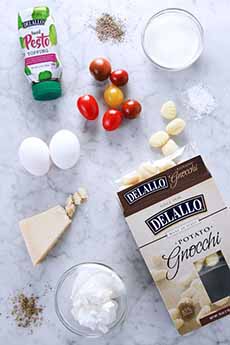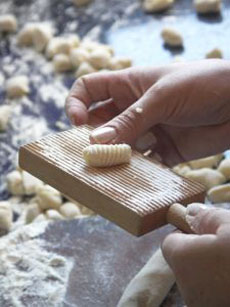RECIPE: Pasta For Breakfast & Brunch
|
Gnocchi for breakfast? It’s a pasta lover’s delight. Eggs, tomatoes, pesto and cheese create an Italian breakfast bake‚—so good and versatile that you can serve it for lunch and dinner, too (photo #1). Thanks to DeLallo for the recipe. You can purchase authentic Italian ingredients on the DeLallo website, including a kit to make your own gnocchi from scratch. We bought ours ready-to-cook, but here’s a gnocchi recipe to make without the kit. Whatever meal you choose, serve the gnocchi bake with a side salad, lightly dressed in vinaigrette. Ingredients For 4-6 Servings 1. PREHEAT the oven to 375°F and grease a 9-by-9-inch square pan. 2. BRING a large pot of salted water to a boil. Cook the gnocchi according to package directions. Drain and set aside. 3. WHISK together the eggs, milk, salt, and pesto. Place the gnocchi in the prepared pan and cover with the egg mixture. Drop heaping spoonsful of ricotta onto the mixture, placing them as evenly as possible throughout the pan. 4. PLACE the tomatoes between dollops of ricotta. Sprinkle with the parmesan and bake until the eggs are completely set and starting to brown, about 30 minutes. 5. REMOVE from the oven and let cool for 10 minutes before serving. A classic Italian pasta, these pillowy potato dumplings (photo #3) delight many pasta lovers. The word “gnocchi” (pronounced N’YAW-kee) has an unknown origin, but it may have derived from the Italian word nocca, meaning knuckle. Another possibility is the Italian word nocchio, meaning a knot in wood. Gnocchi has been a traditional type of Italian pasta—the shape is probably of Middle Eastern origin—since Roman times. It was introduced by the Roman legions during the expansion of the empire into the countries of the European continent. In Roman times, gnocchi were made from a semolina porridge-like dough mixed with eggs [source]. Gnocchi were the perfect peasant food, both filling and inexpensive. Before the potato version was created, gnocchi were made with ingredients such as breadcrumbs and squash. The use of potato is a relatively recent innovation, occurring after the introduction of the potato to Europe in the 16th century (it was one of the food discoveries in the New World). |
|
|
|
Potato gnocchi originated in Northern Italy, where the colder climate was better for growing potatoes than grain. (In fact, a lot of heartier Italian cuisine, including polenta and risotto, originated in Northern Italy.) [source] While gnocchi are dumplings, we like to include them in the group called pillow pasta, stuffed with a pillowy filling. (Ravioli is a pillow pasta. What other varieties can you name? Click the link.) Introduced to different regions of Italy, gnocchi became made variously of semolina, potato or sweet potato; with optional cheese or eggs added to the dough; and optionally flavored with basil, saffron, spinach or tomato. Today, pumpkin is an option. The most common way to prepare gnocchi today is to combine mashed potatoes with flour, although modern variations add different cheeses—goat, gorgonzola, ricotta, Parmigiano-Reggiano. In addition to the flavors noted above, creative chefs make gnocchi in beet, butternut squash, carrot, sweet potato and other flavors. They can be served mixed with vegetables (asparagus, broccoli rabe, cherry tomatoes mushrooms, peas, spinach, etc.) and proteins (chicken, clams, ham, pancetta, sausage). Depending on their flavor, gnocchi pair with many sauces, from simple butter and parmesan or tomato to oxtail or pork ragù. One of our favorites is brown butter with crispy fried sage. Is it time to expand your gnocchi horizons?
|
||





